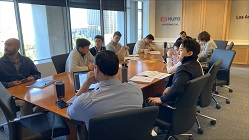MUFG Bank (the Bank) supports its clients' environmental and social risk management and contributes toward a sustainable world by adoption of and adherence to the Equator Principles, a risk management framework for determining, assessing and managing environmental and social risks and impacts for large-scale projects.
The Bank has organized and published our initiatives and activities related to the Equator Principles, issuing the Equator Principles Progress Report.
For more details, please refer to the first edition of the Equator Principles Progress Report(PDF / 3.87MB).
Environmental and social impact assessment and risk management through the Equator Principles
The Bank, as a financier and/or a financial advisor, works in partnership with its clients to determine, assess and manage environmental and social risks and impacts related to the projects.
The Bank adopted the Equator Principles in 2005 to ensure that the projects it finances and advises on are developed in a socially responsible manner and establish good environmental management practices to minimize, mitigate, and/or offset environmental and social risks and impacts.
The Bank supports its clients' environmental and social risk management and contributes toward a sustainable world through implementation of the Equator Principles, a risk management framework for determining, assessing and managing environmental and social risks and impacts for large-scale projects.
The Equator Principles is a financial industry benchmark for determining, assessing and managing environmental and social risk and impacts in projects, which is intended to serve as a common baseline and framework for all the financial institutions adopting the Equator Principles (EPFIs). EPFIs ensure that the projects they finance and advise on are developed in a manner that is socially responsible and reflects sound environmental management practices. As of the end of June 2024, 130 financial institutions worldwide have adopted the Equator Principles.
EPFIs commit to implementing the Equator Principles in their internal environmental and social policies, procedures, and standards for financing projects. EPFIs will not provide loans to projects where the client will not, or is unable to, comply with the Equator Principles. Additionally, in cases where significant environmental and social risks are identified, we voluntarily apply the Equator Principles.
(Please refer to The Equator Principles' official website for more details on the Equator Principles.)

The Bank confirms that environmental and social considerations have been taken into account by clients according to “Implementation Guidelines for the Equator Principles”.
Implementation Guidelines for the Equator Principles(PDF / 250KB)
Confirmation of Environmental and Social Considerations by Environmental and Social Assessment Department, Sustainability Office, Corporate Planning Division
Process for Confirmation of Environmental and Social Considerations
- Environmental and Social Screening
- Environmental and Social Review (Equator Principles Review)
For projects subject to the Equator Principles, ESAD conducts an environmental and social review based on the Equator Principles.
To begin with, in accordance with Principle 1 of The Equator Principles, ESAD categorizes projects proposed for financing based on the magnitude of their potential environmental and social risks and impacts. Following categorization, ESAD confirms whether the projects meet the environmental and social requirements in accordance with the assigned categories.
The results of the environmental and social review are circulated to the credit division, which will take these results into consideration when making credit decisions.
| Principle 1 | Definition of the Categories |
|---|---|
| Category A | Projects with potential significant adverse environmental and social risks and/or impacts that are diverse, irreversible or unprecedented |
| Category B | Projects with potential limited adverse environmental and social risks and/or impacts that are few in number, generally site-specific, largely reversible and readily addressed through mitigation measures |
| Category C | Projects with minimal or no adverse environmental and social risks and/or impacts |
| e.g. Requirements for Category A projects | |
|---|---|
| Principle 2(*1) | Conduct an Environmental and Social Assessment, as appropriate, which includes assessments of potential adverse human rights impacts and climate change risks |
| Principle 3(*2) | Confirmation of the compliance status of applicable environmental and social standards |
| Principle 4 | Develop or maintain an Environmental and Social Management System(ESMS) |
| Prepare an Environmental and Social Management Plan (ESMP) and, where necessary, an Equator Principles Action Plan(EPAP) | |
| Principle 5(*3) | Demonstrate effective stakeholder engagement with affected communities, workers and, where relevant, other stakeholders |
| Principle 6 | Establish a grievance mechanism designed to receive and facilitate resolution of concerns and grievances from Affected Communities |
| Principle 7 | Engage an Independent Environmental and Social Consultant to carry out an independent review of the Assessment Documentation |
| Principle 8 | Incorporate covenants linked to compliance with the Equator Principles |
| Principle 9 | Engage an Independent Environmental and Social Consultant to verify monitoring information to ensure ongoing monitoring and reporting after Financial Close and over the life of the loan |
| Principle 10 | Recommended online disclosure of environmental and social impacts assessments, including a summary of human rights and climate change risks and impacts where deemed appropriate |
Publicly report GHG emission levels (combined Scope 1 and Scope 2 Emissions, and, if appropriate, the GHG efficiency ratio) during the operational phase for projects emitting over 100,000 tonnes of CO2 equivalent annually Encourage clients to share commercially non-sensitive project-specific biodiversity data with the Global Biodiversity Information Facility (GBIF) and other relevant national and global data repositories |
|
Principle 2 of the Equator Principles requires that a client refer to the United Nations Guiding Principles on Business and Human Rights (UNGPs) when assessing human rights risks and impacts. Also, the Climate Change Risk Assessment is aligned with Climate Physical Risk and Climate Transition Risk categories of the Financial Stability Board Task Force on Climate-related Financial Disclosures (TCFD).
- For all Category A and, as appropriate, Category B Projects, and will include consideration of relevant physical risks.
- For all Projects, when combined Scope 1 and Scope 2 Emissions are expected to be more than 100,000 tonnes of CO2 equivalent annually, consideration must be given to relevant Climate Transition Risks and an alternatives analysis completed which evaluates lower Greenhouse Gas (GHG) intensive alternatives
- For Designated Countries, the assessment process evaluates compliance with relevant host country laws, regulations, and permits that pertain to environmental and social issues. In addition to the host country laws, The Bank may evaluate the specific risks of the project to determine whether one or more of the IFC Performance Standards could be used as guidance to address those risks.
- For Non-Designated Countries, the assessment process evaluates compliance with the applicable IFC Performance Standards and the World Bank Group Environmental, Health, and Safety Guidelines (EHS Guidelines).
Principle 5 of the Equator Principles requires projects with the special circumstances defined in IFC Performance Standard 7 paragraphs 13-17 to engage a qualified independent consultant to evaluate the consultation process with Indigenous Peoples, and the outcomes of that process, against the requirements of host country laws and IFC Performance Standard 7.
- Projects with impacts on lands and natural resources subject to traditional ownership or under the customary use of Indigenous Peoples,
- Projects requiring the relocation of Indigenous Peoples from lands and natural resources subject to traditional ownership or under customary use,
- Projects with significant impacts on critical cultural heritage essential to the identity of Indigenous Peoples, or
- Projects using their cultural heritage for commercial purposes.


- Environmental and Social Monitoring

Financial Advisory Service Support
Education and Training
The Bank conducts training for its employees with the objective of deepening their understanding of environmental and social considerations and promoting the philosophy and practices of EP.
The training is primarily targeted at employees in charge of project finance and credit. The Bank also utilizes internal communication measures to promote better understanding of social and environmental considerations by all employees. Additionally, for new appointees, the Bank will provide training on internal procedures for implementing the Equator Principles and case studies that illustrate projects' environmental and social considerations.
The Bank also provides training for customers at their request.


Environmental and Social Consideration and Categorization Report
The Bank discloses the numbers of the project finance transactions and the project-related corporate loans that achieved financial close every year, and the number of the project finance advisory services where the Bank was mandated during the same period in “Environmental and social consideration and categorization report” in accordance with the Equator Principles and the Bank’s Implementation Guidelines for the Equator Principles.
The Bank categorizes the projects proposed for financing based on the magnitude of their potential environmental and social risks and impacts in accordance with the Bank’s Implementation Guidelines for the Equator Principles, referring to the International Finance Corporation (IFC)’s Performance Standards and World Bank Group Environmental, Health, and Safety Guidelines. Especially when assigning Category A to a project, the Bank categorizes the project in accordance with the definition of a Category A project in the Equator Principles referring as appropriate to other guidelines including OECD’s Common Approaches and relevant public institution’s guidelines.
- Starting in 2024, reports under the Equator Principles must be conducted on a calendar year basis, from January to December.
Previously, our bank has conducted its reporting/disclosure based on the fiscal year, which runs from April to March.
To comply with the new requirements, we will be reporting/disclosing our 2023 results over a 9-month, from April to December, as a transitional measure.

